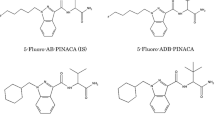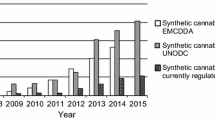Abstract
The popularity of ‘herbal highs’ as an alternative to common illegal drugs is becoming an emerging concern for forensic laboratories and medical facilities. One of the herbal ingredients often claimed by the suppliers to be present in their products is Turnera diffusa, commonly known as ‘damiana,’ which has a long history as a pharmaceutical drug and an intoxicating substance due to its alleged psychoactive effects. The present project focused on the analysis of the chemical signature of damiana for its identification in different herbal blends of forensic interest. Comprehensive two-dimensional gas chromatography proved to be a powerful tool for the extensive analysis of the wide range of volatile compounds present in extracts of damiana and related herbal products. Due to the absence of unique compounds in Turnera diffusa, the chemical pattern has to be considered to ascertain the presence of this species in herbal blends. Differentiation to the closely related species Turnera ulmifolia was provided based on the chemical profile. Compound alignment based on both retention times and mass spectral data revealed the presence of damiana in all ‘herbal high’ products, regardless of whether the presence was declared on the product or not. For several blends, damiana appeared to be the exclusive herbal component. Thus, it confirms the presumption that Turnera diffusa is one of the preferred herbs used as a matrix for ‘herbal high’ products. Utilizing principle component analysis, 31 compounds were selected, which provided discrimination of five commercial damiana batches.







Similar content being viewed by others
References
Auwärter V, Dresen S, Weinmann W, Müller M, Pütz M, Ferreirós N (2009) ‘Spice’ and other herbal blends: harmless incense or cannabinoid designer drugs? J Mass Spectrom 44:832–837
Uchiyama N, Kikura-Hanajiri R, Kawahara N, Goda Y (2009) Identification of a cannabimimetic indole as a designer drug in a herbal product. Forensic Toxicol 27:61–66
Dresen S, Ferreirós N, Pütz M, Westphal F, Zimmermann R, Auwärter V (2010) Monitoring of herbal mixtures potentially containing synthetic cannabinoids as psychoactive compounds. J Mass Spectrom 45:1186–1194
Emanuel CEJ, Ellison B, Banks CE (2010) Spice up your life: screening the illegal components of ‘Spice’ herbal products. Anal Methods 2:614–616
Hudson S, Ramsey J, King L, Timbers S, Maynard S, Dargan PI, Wood DM (2010) Use of high-resolution accurate mass spectrometry to detect reported and previously unreported cannabinomimetics in “herbal high” products. J Anal Toxicol 34:252–260
Uchiyama N, Kawamura M, Kikura-Hanajiri R, Goda Y (2011) Identification and quantitation of two cannabimimetic phenylacetylindoles JWH-251 and JWH-250, and four cannabimimetic naphthoylindoles JWH-081, JWH-015, JWH-200, and JWH-073 as designer drugs in illegal products. Forensic Toxicol 29:25–37
Nakajima J, Takahashi M, Nonaka R, Seto T, Suzuki J, Yoshida M, Kanai C, Hamano T (2011) Identification and quantitation of a benzoylindole (2-methoxyphenyl)(1-pentyl-1H-indol-3-yl)methanone and a naphthoylindole 1-(5-fluoropentyl-1H-indol-3-yl)-(naphthalene-1-yl)methanone (AM-2201) found in illegal products obtained via the Internet and their cannabimimetic effects evaluated by in vitro [35S]GTPγS binding assays. Forensic Toxicol 29:132–141
Simolka K, Lindigkeit R, Schiebel H-M, Papke U, Ernst L, Beuerle T (2012) Analysis of synthetic cannabinoids in “spice-like” herbal highs: snapshot of the German market in summer 2011. Anal Bioanal Chem 404:157–171
Uchiyama N, Kawamura M, Kikura-Hanajiri R, Goda Y (2012) Identification of two new-type synthetic cannabinoids, N-(1-adamantyl)-1-pentyl-1H-indole-3-carboxamide (APICA) and N-(1-adamantyl)-1-pentyl-1H-indazole-3-carboxamide (APINACA), and detection of five synthetic cannabinoids, AM-1220, AM-2233, AM-1241, CB-13 (CRA-13), and AM-1248, as designer drugs in illegal products. Forensic Toxicol 30:114–125
Kneisel S, Bisel P, Brecht V, Broecker S, Müller M, Auwärter V (2012) Identification of cannabimimetic AM-120 and its azepane isomer (N-methylazepan-3-yl)-3-(1-naphthoyl)indole in a research chemical and several herbal mixtures. Forensic Toxicol 30:126–134
Zuba D, Byrska B, Maciow M (2011) Comparison of “herbal highs” composition. Anal Bioanal Chem 400:119–126
Kikuchi H, Uchiyama N, Ogata J, Kikura-Hanajiri R, Goda Y (2010) Chemical constituents and DNA sequence analysis of a psychotropic herbal product. Forensic Toxicol 28:77–83
Ogata J, Uchiyama N, Kikura-Hanajiri R, Goda Y. DNA sequence analyses of blended herbal products including synthetic cannabinoids as designer drugs. Forensic Sci Int (in press). doi:10.1016/j.forsciint.2012.09.006
Rätsch C (2007) Enzyklopädie der psychoaktiven Pflanzen. AT Verlag, Aarau
Kumar S, Taneja R, Sharma A (2005) The Genus Turnera: a review update. Pharm Biol 43:383–391
Alcaraz-Meléndez L, Real-Cosío S, Suchý V, Švajdlenka E (2007) Differences in essential oil production and leaf structure in pheno-types of damiana (Turnera diffusa willd.). J Plant Biol 50:378–382
Auterhoff H, Häufel HP (1968) Inhaltsstoffe der Damiana-Droge. Arch Pharm 301(1968):537–544
Auterhoff H, Momberger H (1972) Inhaltsstoffe des ätherischen Öles aus Damiana-Blättern. Arch Pharm 305:455–462
Bicchi C, Rubiolo P, Saranz Camargo EE, Vilegas W, de Souza Gracioso J, Monteiro Souza Brito AR (2003) Components of Turnera diffusa Willd. var. afrodisiaca (Ward) Urb. essential oil. Flavour Frag J 18:59–61
Zhao J, Pawar RS, Ali Z, Khan IA (2007) Phytochemical investigation of Turnera diffusa. J Nat Prod 70:289–292
Godoi AFL, Vilegas W, Godoi RHM, Van Vaeck L, Van Grieken R (2004) Application of low-pressure gas chromatography-ion-trap mass spectrometry to the analysis of the essential oil of Turnera diffusa (Ward.) Urb. J Chromatogr A 1027:127–130
Garza-Juarez A, Waksman-De-Torres N, Ramirez-Duron R, Cavazos MLS (2009) Development and validation of fingerprints of turnera diffusa extracts obtained by use of high-performance liquid chromatography with diode array detection and chemometric methods. Acta Chromatogr 21:217–235
Tistaert C, Dejaegher B, Heyden YV (2011) Chromatographic separation techniques and data handling methods for herbal fingerprints: a review. Anal Chim Acta 690:148–161
Cordero C, Liberto E, Bicchi C, Rubiolo P, Reichenbach SE, Tian X, Tao Q (2010) Targeted and non-targeted approaches for complex natural sample profiling by GC × GC–qMS. J Chromatogr Sci 48:251–261
Di X, Shellie RA, Marriott PJ, Huie CW (2004) Application of headspace solid-phase microextraction (HS-SPME) and comprehensive two-dimensional gas chromatography (GC × GC) for the chemical profiling of volatile oils in complex herbal mixtures. J Sep Sci 27:451–458
Qiu YQ, Lu X, Pang T, Zhu SK, Kong HW, Xu GW (2007) Study of traditional Chinese medicine volatile oils from different geographical origins by comprehensive two-dimensional gas chromatography-time-of-flight mass spectrometry (GC × GC–TOFMS) in combination with multivariate analysis. J Pharm Biomed Anal 43:1721–1727
Schmarr HG, Bernhardt J (2009) Profiling analysis of volatile compounds from fruits using comprehensive two-dimensional gas chromatography and image processing techniques. J Chromatogr A 1217:565–574
Almstetter MF, Appel IJ, Dettmer K, Gruber MA, Oefner PJ (2011) Comparison of two algorithmic data processing strategies for metabolic fingerprinting by comprehensive two-dimensional gas chromatography-time-of-flight mass spectrometry. J Chromatogr A 1218:7031–7038
Pierce KM, Hoggard JC, Hope JL, Rainey PM, Hoofnagle AN, Jack RM, Wright BW, Synovec RE (2006) Fisher ratio method applied to third-order separation data to identify significant chemical components of metabolite extracts. Anal Chem 78:5068–5075
Gröger T, Welthagen W, Mitschke S, Schäffer M, Zimmermann R (2008) Application of comprehensive two-dimensional gas chromatography mass spectrometry and different types of data analysis for the investigation of cigarette particulate matter. J Sep Sci 31:3366–3374
Gröger T, Schäffer M, Pütz M, Ahrens B, Drew K, Eschner M, Zimmermann R (2008) Application of two-dimensional gas chromatography combined with pixel-based chemometric processing for the chemical profiling of illicit drug samples. J Chromatogr A 1200:8–16
Shellie RA, Welthagen W, Zrostliková J, Spranger J, Ristow M, Fiehn O, Zimmermann R (2005) Statistical methods for comparing comprehensive two-dimensional gas chromatography-time-of-flight mass spectrometry results: metabolomic analysis of mouse tissue extracts. J Chromatogr A 1086:83–90
Nielsen NPV, Carstensen JM, Smedsgaard J (1998) Aligning of single and multiple wavelength chromatographic profiles for chemometric data analysis using correlation optimised warping. J Chromatogr A 805:17–35
Tomasi G, van den Berg F, Andersson C (2004) Correlation optimized warping and dynamic time warping as preprocessing methods for chromatographic data. J Chemometr 18:231–241
Schäffer M, Gröger T, Pütz M, Dieckmann S, Zimmermann R (2012) Comparative analysis of the chemical profiles of 3,4-methylenedioxymethamphetamine based on comprehensive two-dimensional gas chromatography–time-of-flight mass spectrometry (GC × GC-TOFMS). J Forensic Sci 57:1181–1189
Acknowledgments
A part of this work was performed within the project “Spice and synthetic cannabinoids” funded by the EC program “Drug Prevention and Information 2010” (agreement no. JUST/2009/DPIP/AG/0948-30-CE-0379828/00-86).
Author information
Authors and Affiliations
Corresponding author
Rights and permissions
About this article
Cite this article
Schäffer, M., Gröger, T., Pütz, M. et al. Assessment of the presence of damiana in herbal blends of forensic interest based on comprehensive two-dimensional gas chromatography. Forensic Toxicol 31, 251–262 (2013). https://doi.org/10.1007/s11419-013-0186-5
Received:
Accepted:
Published:
Issue Date:
DOI: https://doi.org/10.1007/s11419-013-0186-5




